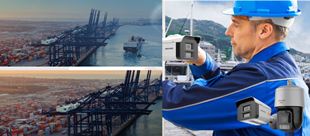08/06/2007
Flir launches new thermal imaging camera for extreme distances
Wilsonville, OR (USA)
This facility allows the cameras to see much more detail once a target has been detected, complementing the excellent situational awareness provided respectively by their 59 x 735mm and 40 x 490mm lenses. Rotating lens systems interrupt visual contact with the target whereas the new HRC cameras allow the operator to gradually zoom in without losing that focus. There is no switching or swapping between images involved to distract the operator.
Being demonstrated for the first time in the UK at IFSEC, the HRC Series is designed to operate over an extremely long range. The cameras are suited for border and coastal surveillance but also for mid-range threat detection. Both cameras are equipped with a highly reliable, mid-wave, cooled indium antimonide (InSb) detector that produces crisp thermal images of 640 x 480 pixels on which the smallest of details can be seen.
These new thermal cameras feature Flir systems' advanced digital detail enhancement that assures clear, good-contrast images even in extremely dynamic thermal scenes. It enforces the cameras' inherent high quality imaging whatever the light level or prevailing weather conditions. They can produce a clear image in total darkness, through light fog and smoke.
In addition to 4x digital zoom the cameras have an auto focus feature that delivers clear images at the press of a button. And focus is retained during image zoom without adjustment. The system ensures greater situational awareness in the wide field of view whilst maintaining detailed recognition capabilities in the narrow field of view.
The HRC-40 x 490 zooms between an 18.8° field of view and a 1.5° field of view. For even longer range performance the HRC-59 x 735 zooms between 9.4° and 0.75°.
Both models are available as a multi-sensor. In this configuration they are equipped with a daylight camera, a GPS unit, digital electromagnetic compass; a laser rangefinder is optionally available. A wide range of functions allows the multi-sensor to be tailored to meet the specific needs of the application. In common with the standard models the multi-sensor can be fixed mounted or installed on a rugged pan and tilt system to increase situational awareness further.
The HRC Series are extremely rugged systems. Their vital core is well protected against humidity and water. Both cameras are easily integrated into legacy and new security systems to provide early detection and visibility 24/7, all year round. Images can be displayed on virtually any existing display that accepts composite video.
The cameras are configured to be fixed mounted or field transportable for fast deployment; a common tripod can be used. A single operator is able to set-up the system in minutes making it ideal for mobile applications. A further option is a rugged pan and tilt system which, via intuitive joystick operation, allows the operator to see 360° horizontal and ±35° vertically giving superb situational awareness. When installed on a pan/tilt, the cameras can be connected to a radar system in a so called "slew to cue" configuration. If the radar detects an object, the camera will automatically turn in the right direction and give you a visual image so that you can instantly see what that radar blip really means. The Pan/Tilt mechanism also allows for easy tracking and following of fast moving objects.
The flexibility of the HRC-40 x 490 and the HRC-59 x 735 thermal imaging cameras make them suitable for a wide variety of ultra long range security and surveillance applications in border control as well as in airports, ports, nuclear and other sensitive industrial facilities.
















